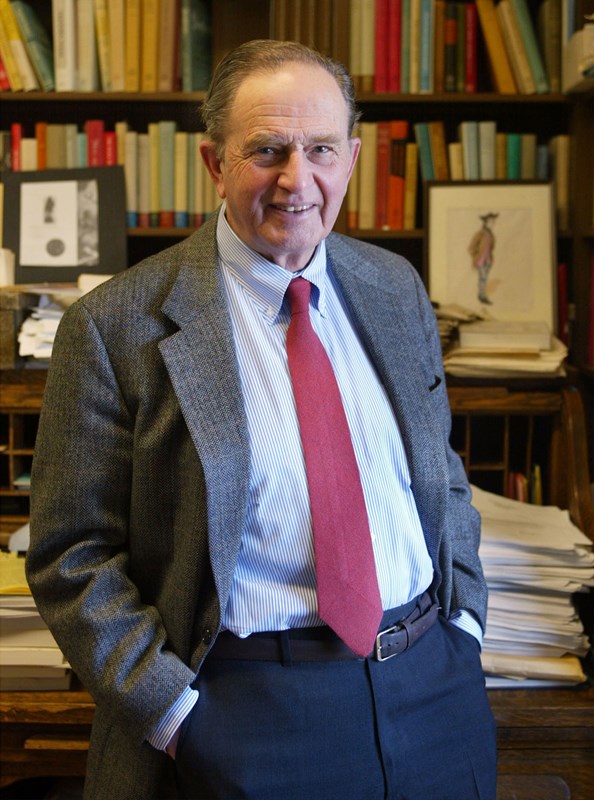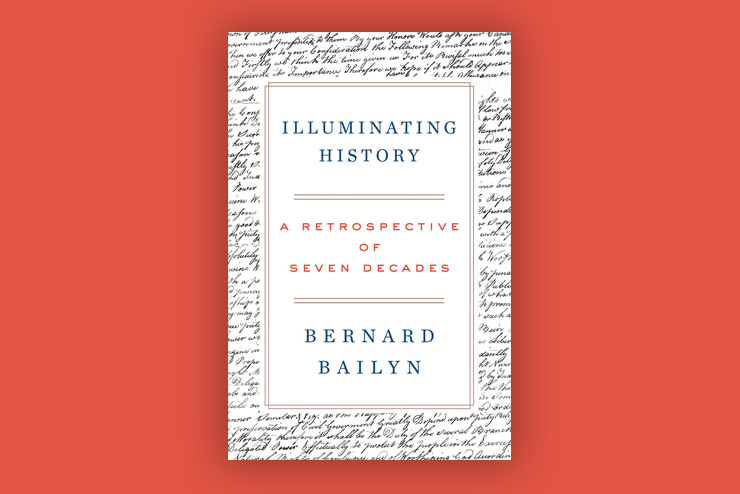Illuminating History: A Retrospective of Seven Decades; by Bernard Bailyn; New York: W.W. Norton & Co., 2020; 288 pp., $28.95
Great historians must be first or primarily expert storytellers, insists historian Bernard Bailyn in his latest book. But the Pulitzer Prize winning author also declares that historians must be social scientists as well. Yet, if greatness entails doing both, Bailyn disappointingly fails to take into account his own limitations and makes little use of his vast experience in deciding whether doing both, at once, is really a reasonable aspiration.
Bailyn was one of the most highly regarded early-national American historians of the latter half of the 20th century, a status that earned him an endowed chair in Early American History at Harvard University. Illuminating History is Bailyn’s last of well over a dozen books, as he died last year at the age of 98, shortly before this work was published. That he was still writing at that advanced age is a testament to his enormous productivity. Illuminating History not only allows us to admire Bailyn’s approach to history, but it also displays his limitations while inviting us to think about the very act of writing history.
This book stands out in a number of ways. First, it was written by a man, late in his career, who was revered by many professional historians. This is evidenced by the great number and stature of those profusely lauding him on the back of the dust jacket.
Second, his last book takes a unique approach to history. Starting with an autobiographical introduction, this book consists of five chapters that are, in truth, almost impossible to characterize. Four of them are written about obscure, albeit fascinating, documents that Bailyn believes illuminate one or more of his previously written books and their putative analytic aims. The fifth chapter is not focused on a particular document but instead rehashes Bailyn’s self-congratulatory role in organizing a series of meetings at Harvard for younger scholars between 1995 and 2013 on “Atlantic history.” The concluding materials are possibly less unusual, containing an epilogue of earlier historiographic selections, followed by an appendix of mostly previously composed memorials delivered on the deaths of Bailyn’s graduate-school advisors.
The book’s first four chapters manifestly fulfill the promise of the book’s title in that each illuminates the writing of history in two ways: one that was done successfully and the other less so.
Consider, for example, the first chapter. It engagingly describes the will of a mid-17th century Boston merchant and powerfully draws us into his story, making clear just how obsessive a man he was in life, and still more so in death. Bailyn links this account to his own 1955 work on New England merchants, as well as to Max Weber’s 1904 The Protestant Ethic and the Spirit of Capitalism. Yet this account does nothing to demonstrate that the will of a dyspeptic and idiosyncratic Boston merchant supports a close connection between orthodox Calvinism and sharp economic practices.
Bailyn ignores that this is a much-disputed connection, seemingly unaware of works challenging Weber, like those of historian Hugh Trevor-Roper. The overarching problem here, as with every substantive chapter in the book—and perhaps throughout Bailyn’s long and storied career—is that the material Bailyn discusses does nothing to advance the theses that he has in mind.
Each of the substantive middle three chapters follow the same pattern: Bailyn discusses some obscure document, claiming that it illuminates a particular stream in modern intellectual or social history. Additionally, and less easy to assess, he asserts that each of these documents builds on one or more of his celebrated works. In each instance—be it data from two New England censuses, returns from Massachusetts towns in response to the proposed constitution of 1780, or the ascetic and musical practices of a German utopian and celibate community—the documents do nothing to explain broader patterns in early-modern social or intellectual history. Nor do they necessarily have any clear and obvious relation to Bailyn’s earlier works.
Completing these chapters, one might reasonably conclude that each of these vignettes was a failure incapable of supporting the analytic claims Bailyn puts forward and that he should have avoided such an embarrassing overreach so late in life. But such a conclusion, even if in some ways true, would be premature, for it is with remarkable skill that Bailyn uses the pieces of each chapter to shine a bright light on a world with which he is, possibly uniquely, familiar.
Each chapter, while never fulfilling the explicit analytical expectations Bailyn outlines for them, is a delight to read. It is easy to understand the way that each of his subjects illuminates something in colonial or New England history. The book uncovers for its readers a lost world.
 Bailyn’s work also illuminates, especially in its general introduction, epilogue, and appendix, different techniques of writing history. In the end materials Bailyn republishes previously written historiographic materials and explores the different approaches taken by his two graduate-school advisors.
Bailyn’s work also illuminates, especially in its general introduction, epilogue, and appendix, different techniques of writing history. In the end materials Bailyn republishes previously written historiographic materials and explores the different approaches taken by his two graduate-school advisors.
One approach is that of a master storyteller, akin, if you will, to a novelist who can create a distant world into which readers enter. This is the method used by the graduate advisor with whom he found little personal connection, Samuel Eliot Morison. Bailyn excelled at this storytelling technique.
The other approach, that of his dissertation director Oscar Handlin, is more akin to that of a social scientist trying to explain varying states of the past and their connections to the present. Though he curiously admired Handlin more than Morison, Bailyn shows himself mostly lacking in the requisite analytical perspective or skills. Still more surprisingly, he seems unaware of his own limitations. Without this recognition, Bailyn is never led to address whether there is a gulf, possibly unbridgeable, between the two historical approaches under discussion, and on display, in his last book.
Only when looking back to the introduction and after reading the epilogue and appendix can one assess the first four chapters. Bailyn explains that the broader analytic patterns of his major chapters are meant to explore the connections between America and Europe and the connection between the ideas of modernity and their manifestation in reality. The documents Bailyn features are meant to be “vital encapsulations of what would become major developments in the emergence of modernity.”
Yet, in a manner hard to exaggerate, none of these documents backs up Bailyn’s claims. Accordingly, throughout much of the book the reader is left exasperated and confused by Bailyn’s wholly unfulfilled promises, while being at the same time powerfully impressed by Bailyn’s superb ability to recreate a long-lost world. Only when one gets to the end of the book and Bailyn discusses in the epilogue and appendix two approaches to doing history is one finally able to understand the strengths and limitations of these chapters.
It is in his epilogue that Bailyn first displays his “understanding of the nature of history and some of the problems of studying and writing about it” which, even if often inadvertently, he does so in impressive ways. Most revealing is how Bailyn sketches those historians whom he considers to have been exceptionally talented. He describes them as being able “to conceive of an entire world and not merely one problem or one issue or one theme…[and in] this capacity these historians are comparable…to the novelists who have created entire worlds.”
Bailyn clearly belongs in his own rubric of historians of genius, yet he holds that historians shouldn’t be satisfied with simply being storytellers, even if they are as great as Morison had been. Historians also must be more than mere students of “sociology or anthropology.” Their histories must be “both a study and a story—that is, structural studies woven into narratives that explain the long-term process of change…”
In the first sentences of his book, Bailyn writes that British philosopher Isaiah Berlin was wrong to classify writers into two categories: hedgehogs and foxes. Hedgehogs are like the storytellers, who view the world through the lens of a single unifying idea, and foxes are like the social scientists, who believe the world cannot be boiled down into a single idea. “Wrong at least as far as historians are concerned,” Bailyn wrote. “Many, like me, are both.”
If this book is exemplary of Bailyn’s approach to history, then it seems that Berlin (and Machiavelli with a similar anthropomorphic frame applied to types of politicians, lions and foxes) are more likely right and Bailyn wrong regarding the rigidity of even the exceptionally talented.
Bailyn might have more directly turned to this fundamental question between the different approaches of Morison and Handlin rather than dealing with it late and only indirectly in the book’s appendix. He describes Morison as, in effect, an amateur rather than a professional historian, because of his focus on storytelling. Handlin, however, was a young man from Brooklyn initially destined for orthodox rabbinic studies in a New York yeshiva. It seems he was less intent on being a storyteller and more intent on explaining the past and making sense of the present. (In so doing, Handlin also presciently critiqued that “diversity became an end in itself,” in trying to explain America’s and Harvard’s less-than-bright future.)
Assessing his two faculty mentors and their different characters and strengths, Bailyn might have told us about how the study and writing of history were transformed by the introduction, shortly before World War II, of professors like Handlin. These men brought an entirely new, analytical perspective to a predominantly Protestant Brahmin environment with its country-club ambience, in which Morison would deliver his storytelling history lectures in riding boots before heading out to his yacht.
Whether the changing nature of the professoriate is related to the two different approaches to doing history is hard to ascertain with confidence, but Bailyn’s failure to address this issue leaves the reader wondering about this possible relationship.
Bailyn’s book succeeds in illuminating a life spent creating great history. He invites the reader to consider whether it is to be found not only in great storytelling, but in clear and probing analysis of the forces of change as well. Both intentionally and unintentionally, Bailyn raises this intriguing question but ultimately fails to address it. Again, it would have been welcome if Bailyn, with his vast experience, had weighed in on the tensions between history as humanist storytelling on the one hand, or as a branch of the social sciences on the other. This might have required a level of self-awareness that Bailyn seemed to lack, from the book’s very first page to its end.

Leave a Reply